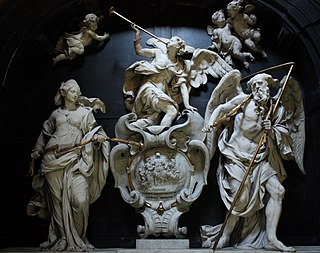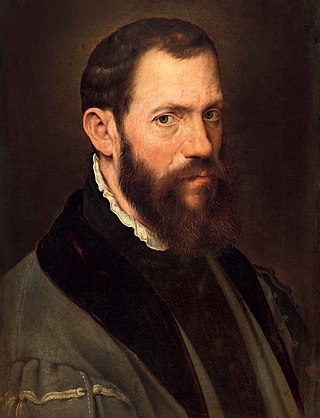

Jacques Jonghelinck (Antwerp, 21 October 1530 - 1606) was a Flemish sculptor and medallist working in Brussels in the Mannerist style common to the Catholic courts of Western Europe.


Jacques Jonghelinck (Antwerp, 21 October 1530 - 1606) was a Flemish sculptor and medallist working in Brussels in the Mannerist style common to the Catholic courts of Western Europe.
He moved from Antwerp to set up a workshop in Brussels in 1562 and was appointed court sculptor the following year.
In Brussels, he specialized in funeral monuments for an aristocratic clientele and was also a successful merchant, and financier. He belonged to the immediate entourage of the diplomat Antoine Perrenot de Granvelle, President of the Council of State from 1556 to 1564.
He collaborated as sculptor and bronze-founder with the sculptor Joos Aerts in the gilt-bronze and black marble memorial of Charles the Bold (died 1477) in the Onze Lieve Vrouwekerk ("Church of Our Lady") (Bruges), completed in 1563.
Letters between de Granvelle, now in Madrid, and his secretary Morillon in Brussels show that Jonghelinck, now as medallist, made a mould for a small medal in the spring of 1566. Successively, he cast medals in lead, tin, copper, silver or gold of the type known as Geuzen medals.
One of his masterworks, a full-length, over-lifesize bronze of Fernando Alvarez de Toledo, Duke of Alba – made in 1569 from the gunmetal of the 16 cannon captured at Jemmingen and erected in the citadel of Antwerp – was destroyed after the death of Alba on orders of King Philip II. Even in Italy and Madrid, the statue was thought to be too pompous and to exhibit unnecessary cruelty. It is a coincidence that Jonghelinck at that moment had already returned to Antwerp, where he was "waardijn" (director) of the mint.
His bronze of Silenus astride a Cask, 1570, is the figure for a fountain in the gardens of the Aranjuez; it replaced Giambologna's Samson and a Philistine, [1] which had been given to Charles, Prince of Wales in 1623, on the ill-fated diplomatic mission over the "Spanish Match".
His brother, Niclaes Jonghelinck, was a major patron of Pieter Brueghel who owned 16 pictures of his by 1565, including many of his best known. [2]

Pieter Bruegelthe Elder was among the most significant artists of Dutch and Flemish Renaissance painting, a painter and printmaker, known for his landscapes and peasant scenes ; he was a pioneer in presenting both types of subject as large paintings.

Giambologna, also known as Jean de Boulogne (French), Jehan Boulongne (Flemish) and Giovanni da Bologna (Italian), was the last significant Italian Renaissance sculptor, with a large workshop producing large and small works in bronze and marble in a late Mannerist style.

Antoine Perrenot de Granvelle, Comte de La Baume Saint Amour, was a Burgundian statesman, made a cardinal, who followed his father as a leading minister of the Spanish Habsburgs, and was one of the most influential European politicians during the time which immediately followed the appearance of Protestantism in Europe; "the dominating Imperial statesman of the whole century". He was also a notable art collector, the "greatest private collector of his time, the friend and patron of Titian and Leoni and many other artists".

Anthonis Mor, also known as Anthonis Mor van Dashorst and Antonio Moro, was a Netherlandish portrait painter, much in demand by the courts of Europe. He has also been referred to as Antoon, Anthonius, Anthonis or Mor van Dashorst, and as Antonio Moro, António Mouro, Anthony More, etc., but signed most of his portraits as Anthonis Mor.

Johannes Michel or John Michael Rysbrack, original name Jan Michiel Rijsbrack, often referred to simply as Michael Rysbrack, was an 18th-century Flemish sculptor, who spent most of his career in England where he was one of the foremost sculptors of monuments, architectural decorations and portraits in the first half of the 18th century. His style combined the Flemish Baroque with Classical influences. He operated an important workshop whose output left an important imprint on the practice of sculpture in England.

Cornelis Floris or Cornelis (II) Floris De Vriendt was a Flemish sculptor, architect, draughtsman, medallist and designer of prints and luxury. He operated a large workshop in Antwerp from which he worked on many large construction projects in Flanders, Germany and Denmark. He was one of the designers of the Antwerp City Hall. He developed a new style, which was informed by Flemish traditions, the 16th century Italian Renaissance and possibly the School of Fontainebleau. His innovations spread throughout Northern Europe where they had a major influence on the development of sculpture and architecture in the 16th and early 17th centuries.

Mathieu Kessels was a Dutch Neoclassical sculptor who mainly worked in Rome.

Baroque sculpture is the sculpture associated with the Baroque style of the period between the early 17th and mid 18th centuries. In Baroque sculpture, groups of figures assumed new importance, and there was a dynamic movement and energy of human forms—they spiralled around an empty central vortex, or reached outwards into the surrounding space. Baroque sculpture often had multiple ideal viewing angles, and reflected a general continuation of the Renaissance move away from the relief to sculpture created in the round, and designed to be placed in the middle of a large space—elaborate fountains such as Gian Lorenzo Bernini‘s Fontana dei Quattro Fiumi, or those in the Gardens of Versailles were a Baroque speciality. The Baroque style was perfectly suited to sculpture, with Bernini the dominating figure of the age in works such as The Ecstasy of St Theresa (1647–1652). Much Baroque sculpture added extra-sculptural elements, for example, concealed lighting, or water fountains, or fused sculpture and architecture to create a transformative experience for the viewer. Artists saw themselves as in the classical tradition, but admired Hellenistic and later Roman sculpture, rather than that of the more "Classical" periods as they are seen today.

Jacob Franquart or Jacob Franckaert the Younger was a Flemish architect, painter, print artist, draftsman, military engineer and poet. He is known for his altarpieces and publications on contemporary Italian architecture. He was employed by the court of the Archdukes Albert and Isabella in Brussels as a painter and architect. He was responsible for the design of ephemeral decorations and structure for important occasions at the court such as funerals. As an architect and decorator, he introduced the Baroque in the buildings of the Habsburg Netherlands. His style is sometimes referred to as the Italo-Flemish style and became very popular in Flanders in the 17th century. Only a few paintings are attributed to him.

Otto van Veen, also known by his Latinized names Otto Venius or Octavius Vaenius, was a painter, draughtsman, and humanist active primarily in Antwerp and Brussels in the late 16th and early 17th centuries. He is known for his paintings of religious and mythological scenes, allegories and portraits, which he produced in his large workshop in Antwerp. He further designed several emblem books, and was from 1594 or 1595 to 1598 the teacher of Rubens. His role as a classically educated humanist artist, was influential on the young Rubens, who would take on that role himself. He was court painter of successive governors of the Habsburg Netherlands, including the Archdukes Albert and Isabella.

Leone Leoni was an Italian sculptor of international outlook who travelled in Italy, Germany, Austria, France, Spain and the Netherlands. Leoni is regarded as the finest of the Cinquecento medallists. He made his reputation in commissions he received from the Habsburg monarchs Charles V, Holy Roman Emperor and Philip II of Spain. His usual medium was bronze, although he also worked in marble and alabaster, carved gemstones and probably left some finished work in wax, as well as designing coins. He mainly produced portraits, and was repeatedly used by the Spanish, and also the Austrian, Habsburgs.
Jean or Jehan Scheyfve, Lord of Sint-Agatha-Rode, was Chancellor of Brabant, head of the civilian administration of the Duchy of Brabant, from 1557 to 1579. He had earlier served as the ambassador of Charles V, Holy Roman Emperor, to the English court.

The Procession to Calvary is an oil-on-panel by the Netherlandish Renaissance artist Pieter Bruegel the Elder of Christ carrying the Cross set in a large landscape, painted in 1564. It is in the Kunsthistorisches Museum in Vienna.

The family of de Pannemaeker or de Pannemaker were tapestry weavers from the Southern Netherlands, more or less equivalent to modern-day Belgium. Pieter de Pannemaeker, working from Brussels, was a celebrated weaver who, for European royalty, created tapestries resplendent with gold and silver threads, and expensive fine silks and woollen items. In 1520, Pieter de Pannemaeker commissioned the artist Bernard van Orley to make tapestry cartoons for his workshop. A surviving fragment depicts the Allegory of the Four Winds. Pannemaeker was court weaver to Margaret of Austria, Regent of the Southern Netherlands, who commissioned the Passion in four parts, and in 1523, she ordered an imposing dais made up of three tapestries, which later featured in the abdication ceremony of Emperor Charles V.
Despite its size, Belgium has a long and distinguished artistic tradition that goes back to the Middle Ages, considerably pre-dating the foundation of the current state in 1830. Art from the areas making up modern Belgium is called in English Netherlandish up to the separation with the Netherlands from 1570 on, and Flemish until the 18th century.

Mattheus van Beveren was a Flemish sculptor and medalist who is mainly known for his monumental Baroque church sculptures and small wood and ivory sculptures. He also made medals and die designs for the Antwerp Mint.

Willem van den Broecke, Willem van den Broeck or Guillelmus Paludanus was a Flemish sculptor, painter, draughtsman and architect. He was a scion of a family of artists, which had its origins in Mechelen and some members of which later moved to Antwerp. Willem was active in Antwerp and also worked and likely trained in Italy for a long period. He was known for his small scale works, many of which were executed in alabaster. He was, along with Cornelis Floris, the leading sculptor in Antwerp in the second half of the 16th century. He was also one of the designers of the Antwerp City Hall. He enjoyed the patronage of an elite international clientele of church institutions, Spanish nobility, princes of Protestant territories as well as patricians from Augsburg.

Nicolaes Jonghelinck (1517–1570) was a merchant banker and art collector from Antwerp. He is best known for his collection of paintings by Pieter Bruegel the Elder and Frans Floris. His brother was the sculptor Jacques Jonghelinck.

Jacopo da Trezzo was an Italian Renaissance sculptor of medals and jeweller, who after beginning his career in Milan moved to employment by the Spanish Habsburgs in 1554. He spent the rest of his career working for the Spanish court, beginning by visiting England in 1554–55 during the marriage of Philip II of Spain and Mary I of England, which lasted from 1554 to her death in 1558.